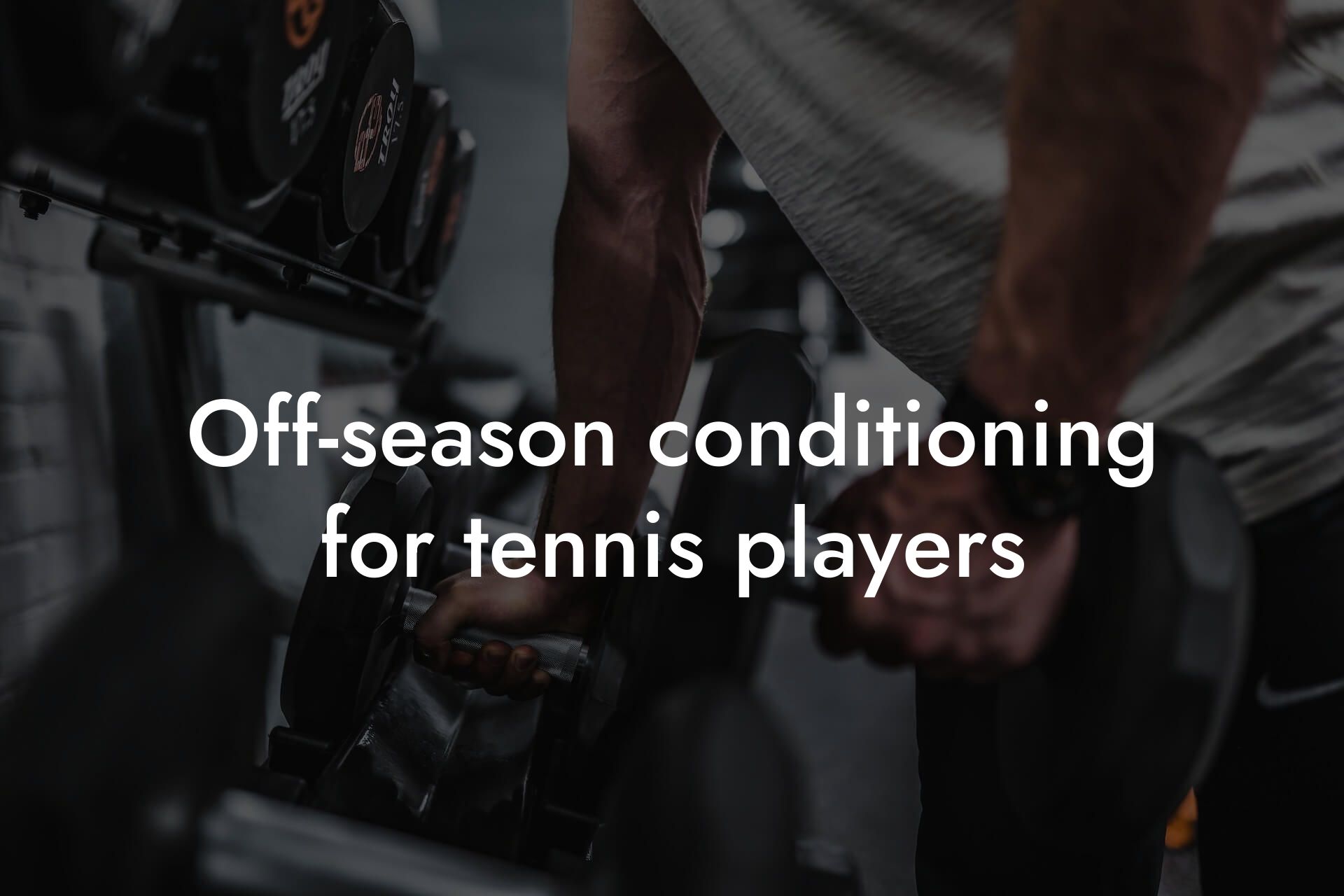Introduction
As a tennis athlete, you understand the importance of having a strong and agile body to excel on the court. Strength training is a crucial component of any tennis player's regimen, as it enhances power, speed, agility, and endurance. A well-structured strength training program can help you dominate your opponents, reduce the risk of injury, and take your game to the next level. In this article, we will delve into the world of strength training programs for tennis athletes, exploring the benefits, exercises, and periodization strategies to help you achieve peak performance.
Table of Contents
- Introduction
- Benefits of Strength Training for Tennis Athletes
- Key Exercises for Tennis Athletes
- Periodization Strategies for Tennis Athletes
- Incorporating Plyometrics and Agility Training
- Injury Prevention and Management
- Monitoring Progress and Adjusting the Program
- Get a Comprehensive Body Assessment with DEXA
- Frequently Asked Questions
Benefits of Strength Training for Tennis Athletes
Strength training offers numerous benefits for tennis athletes, including:
• Increased power and speed: Strength training helps develop explosive power, enabling you to hit stronger shots and cover more ground on the court.
• Enhanced endurance: Building muscular endurance allows you to maintain a high level of intensity throughout long matches and tournaments.
• Improved agility and quickness: Strength training exercises that focus on rapid contractions and decelerations can improve your reaction time and agility.
• Reduced injury risk: Strengthening muscles around joints and ligaments can help prevent injuries and reduce the risk of overuse.
• Better overall athleticism: Strength training can improve your overall athleticism, allowing you to dominate in other areas of your game, such as serving and volleying.
Key Exercises for Tennis Athletes
A comprehensive strength training program for tennis athletes should include exercises that target the following muscle groups:
• Legs: Squats, lunges, deadlifts, and leg press exercises are essential for building power and speed.
• Core: Exercises like planks, Russian twists, and side planks can improve rotational power and stability.
• Shoulders: Strengthening the shoulders with exercises like shoulder rotations, lateral raises, and front raises can enhance serving and overhead shots.
• Back: Lat pulldowns, rows, and Superman exercises can improve posture, reduce injury risk, and enhance overall athleticism.
• Arms: Building forearm strength with exercises like wrist curls and extensions can improve grip strength and racquet control.
Periodization Strategies for Tennis Athletes
A well-structured periodization plan is crucial for tennis athletes, as it allows for optimal training and recovery. A typical periodization plan for tennis athletes consists of:
• Off-season (4-6 weeks): Focus on building overall strength and endurance with high-volume, low-intensity training.
• Pre-season (4-6 weeks): Shift to high-intensity, low-volume training to develop power and speed.
• In-season (12-16 weeks): Reduce training volume and intensity, focusing on maintenance and active recovery.
• Transition phase (2-4 weeks): Gradually decrease training intensity and volume to allow for recovery and rejuvenation.
Incorporating Plyometrics and Agility Training
Plyometric and agility training are essential components of any tennis athlete's strength training program. These exercises can help improve:
• Explosive power: Plyometric exercises like box jumps and depth jumps can enhance power and speed.
• Reaction time: Agility drills like cone drills and ladder drills can improve reaction time and quickness.
• Change of direction: Agility training can help tennis athletes develop the ability to quickly change direction and accelerate on the court.
Injury Prevention and Management
Injury prevention and management are critical components of any strength training program for tennis athletes. Some tips for preventing injuries include:
• Gradually increasing training intensity and volume
• Incorporating exercises that strengthen muscles around joints and ligaments
• Focusing on proper technique and form
• Incorporating active recovery techniques like foam rolling and stretching
Monitoring Progress and Adjusting the Program
Regularly monitoring progress and adjusting the strength training program is crucial for tennis athletes. Some ways to monitor progress include:
• Tracking workout metrics like weight, reps, and sets
• Conducting regular fitness assessments and body composition analysis
• Working with a coach or trainer to adjust the program based on performance and goals
A well-structured strength training program is essential for tennis athletes looking to take their game to the next level. By incorporating exercises that target key muscle groups, periodization strategies, plyometrics and agility training, and injury prevention and management techniques, tennis athletes can improve their power, speed, agility, and endurance. Remember to regularly monitor progress and adjust the program to ensure optimal results. With the right strength training program, you can dominate on the court and achieve peak performance.
Get a Comprehensive Body Assessment with DEXA
At Tano Performance Group, we understand the importance of having a comprehensive understanding of your body composition and fitness level. Our DEXA machine provides a detailed analysis of your body fat percentage, lean mass, bone density, and other key metrics. With this information, you can tailor your strength training program to your specific needs and goals. Contact us today to schedule a DEXA scan and take the first step towards achieving peak performance.
Frequently Asked Questions
What is the importance of strength training for tennis athletes?
Strength training is essential for tennis athletes as it enhances their overall performance, reduces the risk of injuries, and improves their durability on the court. A well-structured strength training program can help tennis players develop the power, speed, and agility needed to excel in their sport.
How does strength training benefit tennis players?
Strength training benefits tennis players in several ways, including increased muscle strength, improved power generation, enhanced speed and agility, better endurance, and reduced risk of injuries. It also helps players to maintain a strong core, improve their serving and volleying techniques, and enhance their overall athletic performance.
What are the key components of a strength training program for tennis athletes?
A comprehensive strength training program for tennis athletes should include exercises that target the upper body, lower body, core, and legs. It should also incorporate plyometric exercises, agility drills, and functional training to improve power, speed, and agility.
How often should tennis players strength train?
The frequency of strength training for tennis players depends on their current fitness level, training goals, and competition schedule. Generally, tennis players should aim to strength train 2-3 times per week, with at least one day of rest in between sessions.
What are the best exercises for tennis players?
The best exercises for tennis players include squats, lunges, deadlifts, bench press, rows, and shoulder press. These exercises target the major muscle groups and help improve strength, power, and endurance.
How can tennis players incorporate plyometric exercises into their strength training program?
Tennis players can incorporate plyometric exercises such as box jumps, depth jumps, and resisted sprints into their strength training program to improve their power and explosiveness.
What is the role of core strength in tennis?
Core strength is essential for tennis players as it helps them maintain good posture, generate power, and transfer force from their lower body to their upper body. A strong core also reduces the risk of injuries and improves overall athletic performance.
How can tennis players improve their agility and speed?
Tennis players can improve their agility and speed by incorporating agility drills, shuttle runs, and resisted sprints into their strength training program. These exercises help improve their reaction time, acceleration, and deceleration.
What is the importance of functional training for tennis players?
Functional training is essential for tennis players as it helps them develop the strength, power, and endurance needed to perform tennis-specific movements such as serving, volleying, and forehand and backhand strokes.
How can tennis players incorporate functional training into their strength training program?
Tennis players can incorporate functional training into their strength training program by using exercises that mimic tennis-specific movements, such as medicine ball tosses, resistance band exercises, and plyometric exercises.
What is the role of periodization in strength training for tennis players?
Periodization is essential in strength training for tennis players as it helps them avoid plateaus, reduce the risk of overtraining, and peak at the right time. A well-structured periodized program helps tennis players achieve their training goals and improve their overall performance.
How can tennis players periodize their strength training program?
Tennis players can periodize their strength training program by dividing their training into specific phases, such as hypertrophy, strength, power, and endurance. Each phase should have specific training goals and exercises tailored to achieve those goals.
What is the importance of nutrition and recovery in strength training for tennis players?
Nutrition and recovery are essential for tennis players as they help them fuel their bodies, recover from intense training, and adapt to the demands of their sport. A well-structured nutrition and recovery plan helps tennis players optimize their training and improve their overall performance.
How can tennis players optimize their nutrition and recovery?
Tennis players can optimize their nutrition and recovery by fueling their bodies with a balanced diet, staying hydrated, getting adequate sleep, and incorporating recovery techniques such as stretching, foam rolling, and massage into their training program.
What are the common mistakes tennis players make in their strength training program?
The common mistakes tennis players make in their strength training program include inadequate warm-up and cool-down, poor exercise technique, insufficient recovery time, and inadequate nutrition and hydration.
How can tennis players avoid common mistakes in their strength training program?
Tennis players can avoid common mistakes in their strength training program by working with a qualified coach or trainer, following a well-structured training program, and prioritizing nutrition, recovery, and injury prevention.
What is the role of strength training in injury prevention for tennis players?
Strength training plays a crucial role in injury prevention for tennis players as it helps them develop the strength, power, and endurance needed to withstand the demands of their sport. A well-structured strength training program also helps tennis players improve their flexibility, mobility, and proprioception, reducing the risk of injuries.
How can tennis players use strength training to rehabilitate from injuries?
Tennis players can use strength training to rehabilitate from injuries by incorporating exercises that target the affected area, improving their strength, power, and endurance, and gradually progressing to more intense exercises and drills.
What is the importance of flexibility and mobility in strength training for tennis players?
Flexibility and mobility are essential for tennis players as they help them maintain good posture, generate power, and move efficiently around the court. A well-structured strength training program should include exercises that improve flexibility and mobility.
How can tennis players improve their flexibility and mobility?
Tennis players can improve their flexibility and mobility by incorporating stretching exercises, foam rolling, and dynamic warm-ups into their strength training program.
What is the role of mental toughness in strength training for tennis players?
Mental toughness is essential for tennis players as it helps them push through challenging training sessions, overcome obstacles, and stay focused during competition. A well-structured strength training program should include exercises that challenge tennis players mentally and physically.
How can tennis players develop mental toughness through strength training?
Tennis players can develop mental toughness through strength training by incorporating exercises that challenge their mental and physical limits, such as high-intensity interval training, plyometric exercises, and strength exercises with heavy loads.
What is the importance of consistency and patience in strength training for tennis players?
Consistency and patience are essential for tennis players as they help them make progressive gains in their strength training program, avoid plateaus, and achieve their training goals.
How can tennis players stay consistent and patient in their strength training program?
Tennis players can stay consistent and patient in their strength training program by setting realistic goals, tracking their progress, and celebrating small victories along the way.
Here are some related articles you might love...
- The importance of DEXA scans for tennis players
- Off-season conditioning for tennis players
- How to maintain endurance during long tennis matches
- The role of bone density in preventing tennis injuries
- Improving core strength for better tennis strokes
- How body composition impacts tennis agility and speed
- Nutrition strategies for sustained energy during tennis matches
- Reducing body fat to enhance tennis performance
- Recovery techniques for tennis professionals
Zak Faulkner
Zak Faulkner is a leading authority in the realm of physical health and body composition analysis, with over 15 years of experience helping professionals optimise their fitness and well-being. As one the experts behind Tano Performance Group, Zak has dedicated his career to providing in-depth, science-backed insights that empower clients to elevate their physical performance and overall health.
With extensive knowledge of DEXA technology, Zak specializes in delivering comprehensive body assessments that offer precise data on body fat, muscle mass, bone density, and overall physique. His expertise enables individuals to make informed decisions and achieve their fitness goals with accuracy and confidence. Zak’s approach is rooted in a deep understanding of human physiology, combined with a passion for helping clients unlock their full potential through personalised strategies.
Over the years, Zak has earned a reputation for his commitment to excellence, precision, and client-focused service. His guidance is trusted by top professionals who demand the best when it comes to their health. Whether advising on fitness programs, nutritional strategies, or long-term wellness plans, Zak Faulkner’s insights are a valuable resource for anyone serious about taking their health and fitness to the next level.
At Tano Performance Group, Zak continues to lead our Content Team revolutionising how professionals approach their physical health, offering unparalleled expertise that drives real results.




